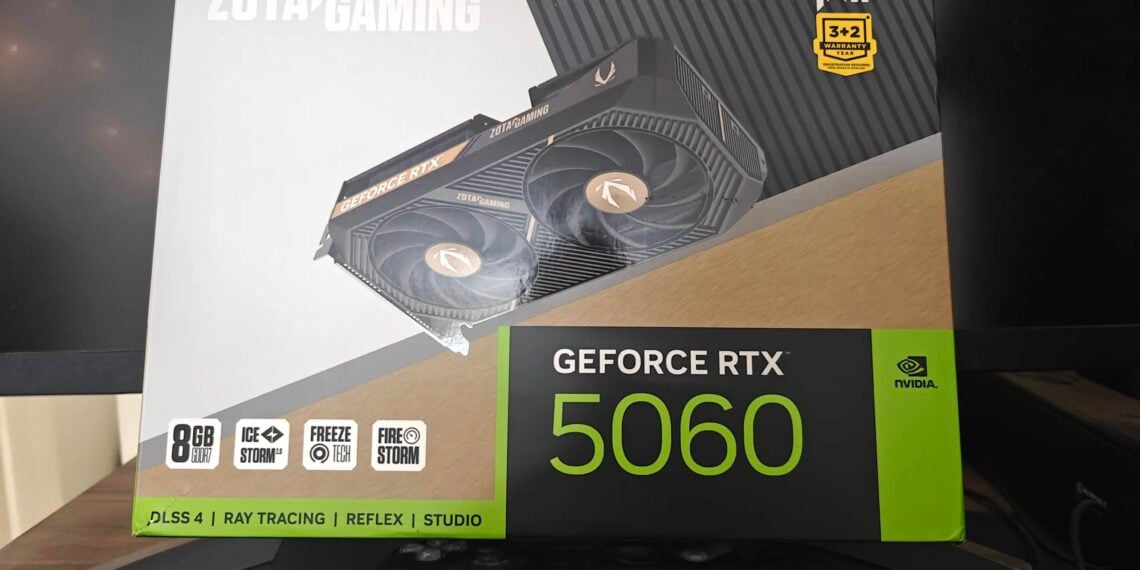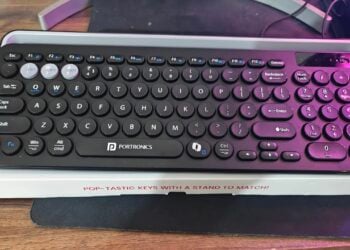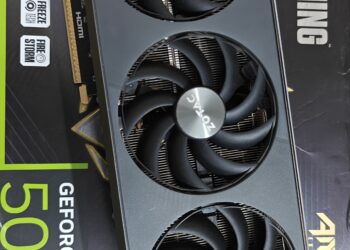The ZOTAC Gaming GeForce RTX 5060 Twin Edge represents an intriguing proposition in the budget gaming GPU market. Powered by NVIDIA’s cutting-edge Blackwell architecture and featuring ultra-fast GDDR7 memory, this compact card promises exceptional 1080p gaming performance. But does the 8GB VRAM limitation hold it back? Let’s dive deep into this comprehensive review.
Table of Contents
Quick Specifications Overview
| Specification | Details |
|---|---|
| GPU Architecture | NVIDIA Blackwell (GB206) |
| CUDA Cores | 3,840 cores |
| Memory | 8GB GDDR7 |
| Memory Speed | 28 Gbps |
| Memory Bandwidth | 448 GB/s |
| Boost Clock | ~2,497 MHz |
| Power Consumption | 160-180W (TDP) |
| Power Connector | Single 8-pin PCIe |
| PCIe Interface | PCIe 5.0 x8 |
| Dimensions | 220.5mm x 2-slot (41.6mm thick) |
| Display Outputs | 3x DisplayPort 2.1b, 1x HDMI 2.1b |
| MSRP | $299 USD |
| Buy Now | Amazon Link |
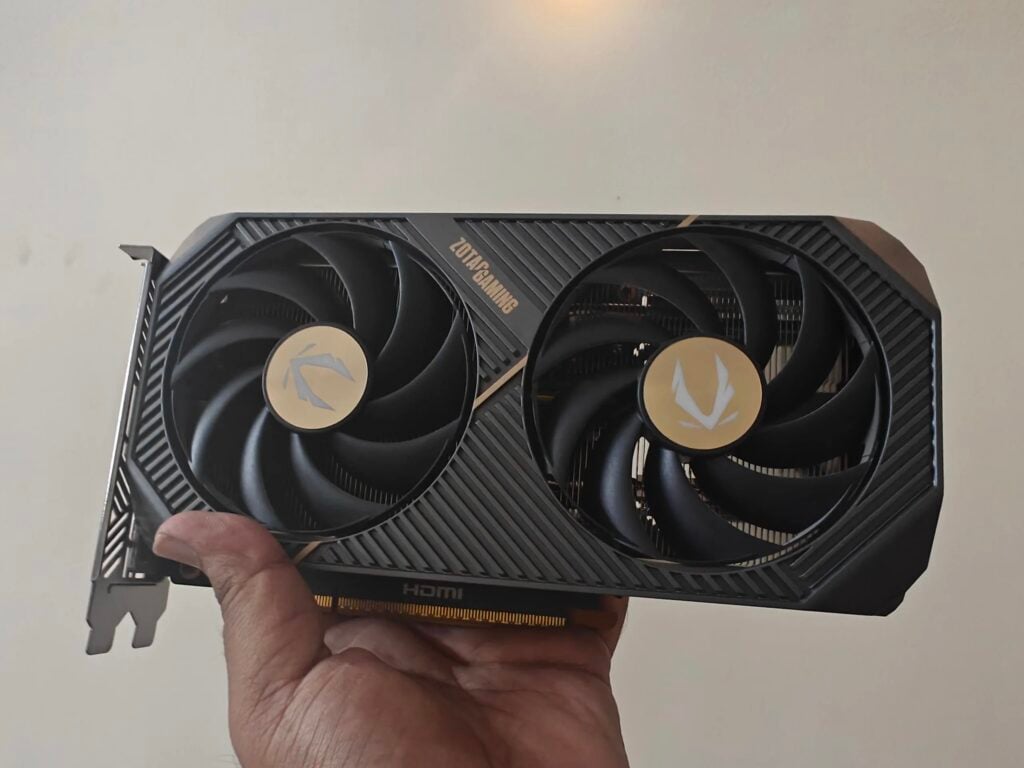
Design and Build Quality: Small Form Factor Champion
The ZOTAC Gaming GeForce RTX 5060 Twin Edge is a compact graphics card powered by NVIDIA’s cutting-edge Blackwell Architecture, DLSS4, and 8GB of GDDR7 memory, featuring a solid cooling solution ready to take on the latest title releases.
Compact Aesthetics
The Twin Edge lives up to its name with a minimalist design philosophy. At just 220.5mm in length and occupying a true 2-slot footprint, this card is perfectly suited for small form factor (SFF) builds. The card has shrunk to 220.5mm in length from previous generations while growing slightly from 40.2mm thick to 41.6mm thick.
The matte black shroud features subtle design accents without RGB lighting—a refreshing approach for builders prioritizing understated aesthetics. The metal backplate adds structural rigidity and helps with heat dissipation, giving the card a premium feel despite its budget positioning.
Cooling Solution: IceStorm 2.0
The ZOTAC Gaming GeForce RTX 5060 Series utilizes IceStorm 2.0 cooling solution featuring card-length heat sinks, composite heat pipes, and open ventilation where cooling is optimized for peak graphics performance.
BladeLink Fan Technology: The dual 90mm fans feature interconnected blades that create a more concentrated airflow stream for effective GPU cooling. These fans also benefit from increased structural rigidity, improving durability over traditional designs.
FREEZE Fan Stop: When GPU temperatures drop below a certain threshold during light loads or idle, the fans stop completely for silent operation and extended fan lifespan.
Power Delivery
One of the Twin Edge’s most practical features is its single 8-pin PCIe power connector. The card uses the good old 8-pin PCIe power connector, which feels appropriate for a GPU with modest power draw. This makes it compatible with virtually any power supply without requiring adapter cables, unlike some modern GPUs that demand 16-pin connectors.
ZOTAC recommends a minimum 650W power supply, though most quality 550W PSUs should handle this card comfortably in typical gaming systems.

Gaming Performance Benchmarks: The Reality Check
1080p Gaming: Sweet Spot Performance
At 1080p, the RTX 5060 delivered impressive performance, averaging 101 fps in Hogwarts Legacy—slightly faster than the RTX 3070, significantly ahead of the 4060 Ti, and 44% faster than the RTX 4060.
Popular AAA Titles (1080p Ultra Settings):
| Game | Average FPS | 1% Low FPS | Comparison to RTX 4060 |
|---|---|---|---|
| Cyberpunk 2077 (Rasterized) | 125 FPS | ~95 FPS | +23% faster |
| Cyberpunk 2077 (RT + DLSS Balanced) | 164 FPS | ~120 FPS | Significant uplift |
| Hogwarts Legacy | 101 FPS | ~78 FPS | +44% faster |
| Warhammer 40K: Space Marine 2 | 100 FPS | ~82 FPS | +23% faster |
| Star Wars Jedi: Survivor | 95 FPS | ~75 FPS | +30% faster |
| Call of Duty: Black Ops 6 | 75 FPS | ~62 FPS | +10% faster |
| Counter-Strike 2 (Medium) | 370 FPS | ~280 FPS | +27% faster |
| Dying Light 2 | 66 FPS | ~52 FPS | +21% faster |
In raw rasterization at native settings, the RTX 5060 shows itself to be a comfortable 1080p powerhouse, with Cyberpunk 2077 running at 125 FPS and Horizon Zero Dawn reaching 147 FPS at 1080p.
Key Takeaway: At 1080p, the RTX 5060 delivers excellent performance in most modern titles, consistently outperforming the RTX 4060 by 20-30% and matching or exceeding the RTX 3070/4060 Ti in many scenarios.
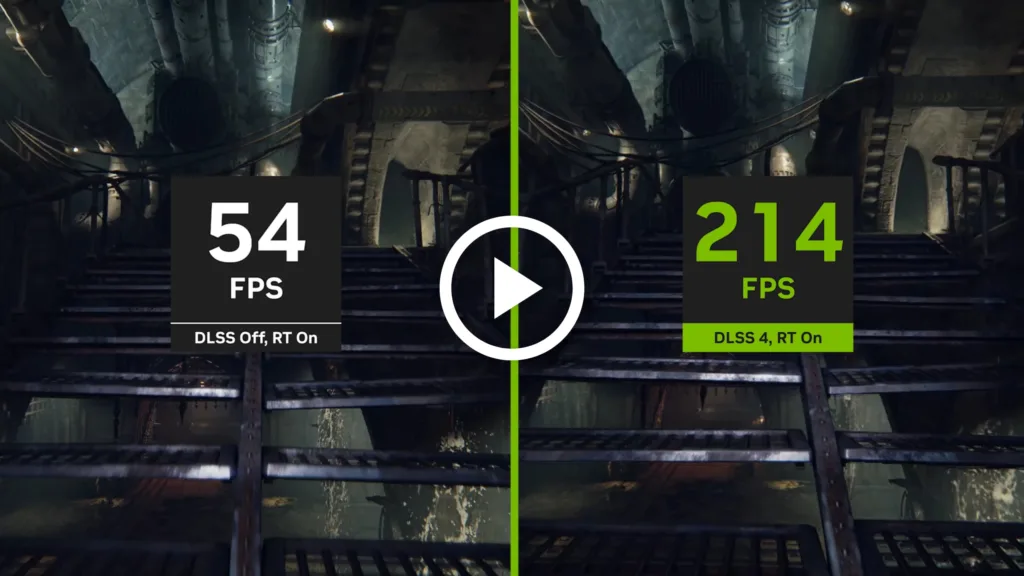
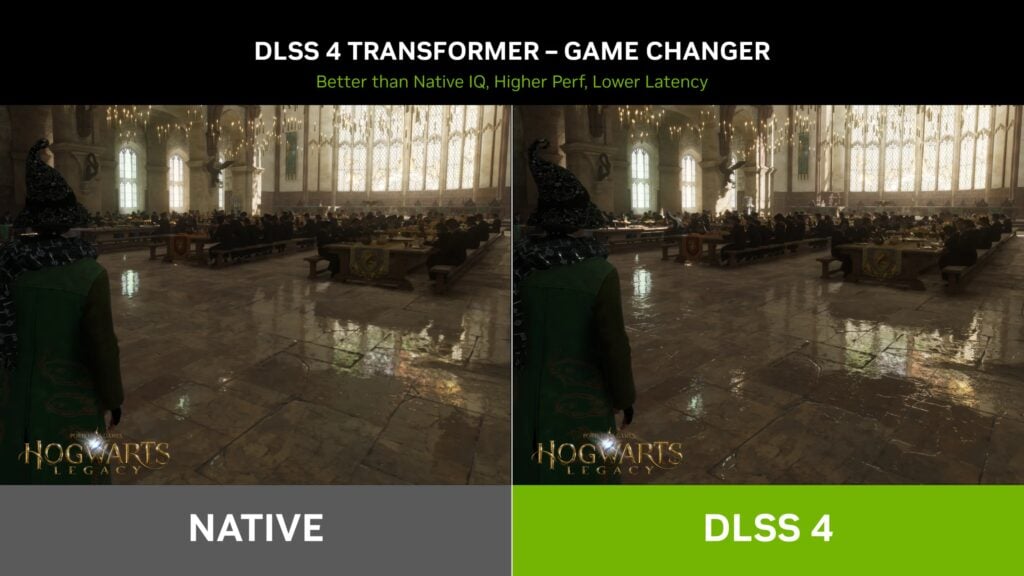
1440p Gaming: Where Limitations Surface
At 1440p, several examples showed where 8GB GPUs began to fall apart. In some cases, performance appeared acceptable, but visual quality suffered due to missing textures that couldn’t fit into local video memory.
1440p Ultra Performance:
| Game | Average FPS | VRAM Usage | Notes |
|---|---|---|---|
| Cyberpunk 2077 | 81 FPS | 7.8GB+ | Playable but near limit |
| Cyberpunk 2077 (RT) | 29 FPS | 8GB+ | DLSS required |
| Hogwarts Legacy | ~65 FPS | 7.5GB | Minor texture pop-in |
| The Last of Us Part I | Inconsistent | 8GB+ saturated | Frame time issues |
| S.T.A.L.K.E.R. 2 | 6 FPS | VRAM saturated | Unplayable at High |
| Dying Light 2 | 62 FPS | 7.2GB | Generally stable |
The GeForce RTX 5060 and 4060 are poorly suited for 1440p, with many titles delivering unplayable performance due to a VRAM bottleneck or limited shader compute.
The VRAM Wall: Several modern titles exceed 8GB VRAM requirements at 1440p ultra settings, resulting in texture streaming issues, stuttering, and dramatically reduced performance. Games like The Last of Us Part I, S.T.A.L.K.E.R. 2, and Indiana Jones struggle significantly.
Ray Tracing Performance: DLSS 4 to the Rescue
At 1080p with upscaling, the RTX 5060 runs at 64 FPS average in Black Myth: Wukong with ray tracing, roughly equal to the 4060 Ti 16GB and 3080.
Ray Tracing Benchmarks (1080p with DLSS):
| Game | RT + DLSS Balanced | RT + MFG 2x | RT + MFG 4x |
|---|---|---|---|
| Cyberpunk 2077 | 72 FPS | 120 FPS | 154 FPS |
| Black Myth: Wukong | 64 FPS | ~95 FPS | ~140 FPS |
| Dragon’s Dogma 2 | 45 FPS | ~68 FPS | ~98 FPS |
DLSS 4 multi frame generation pushes things even further. In Cyberpunk 2077, enabling the RTX 50-series exclusive feature yields 172 FPS at 1440p with the 2x setting, while the 4x mode jumps all the way to 264 FPS.
Important Note: Multi frame generation is still in its early stage, meaning you may face visual artifacts like motion blur, ghosting, and sparkling due to the AI algorithm’s interpolation in fast-moving scenes.
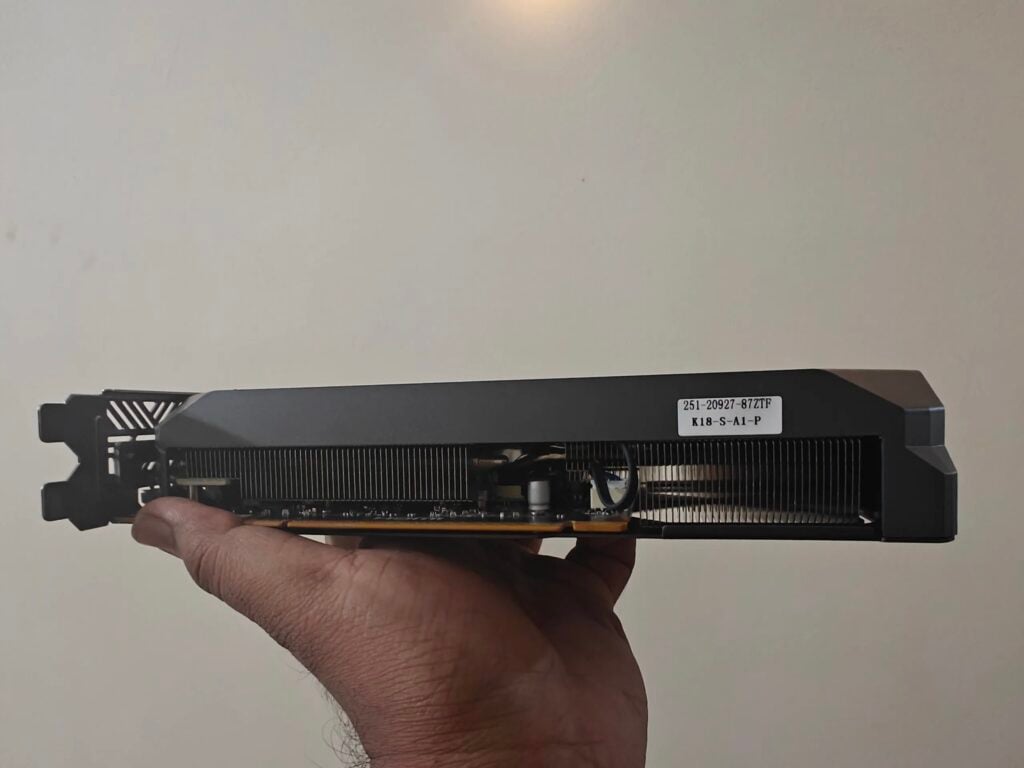
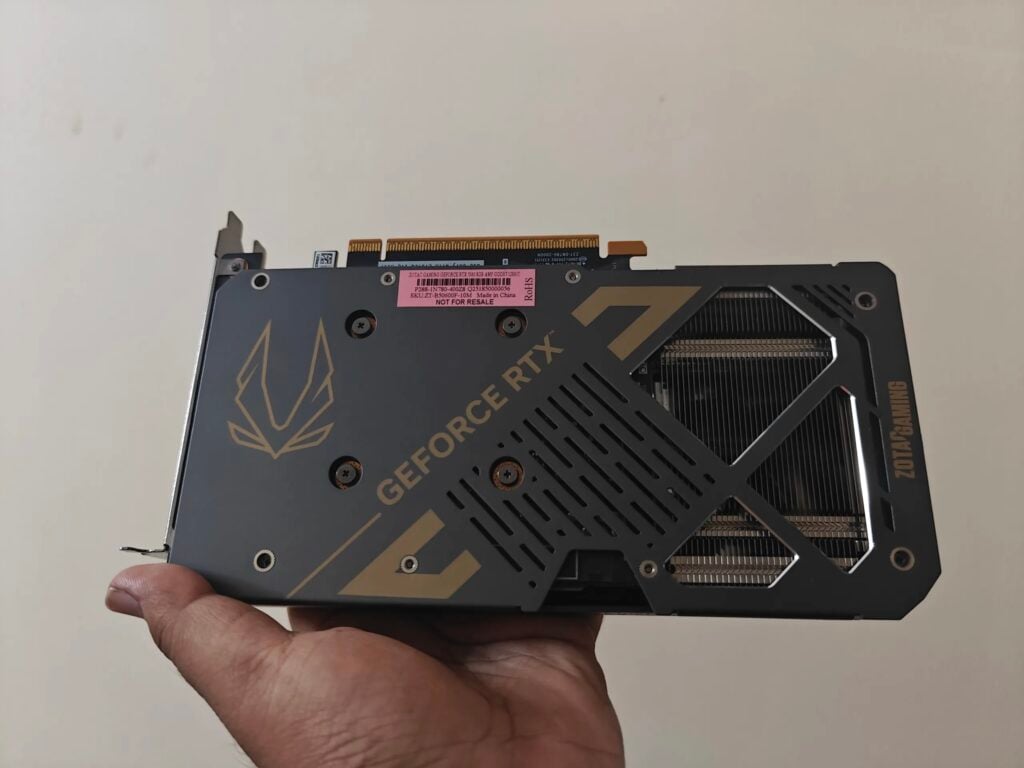
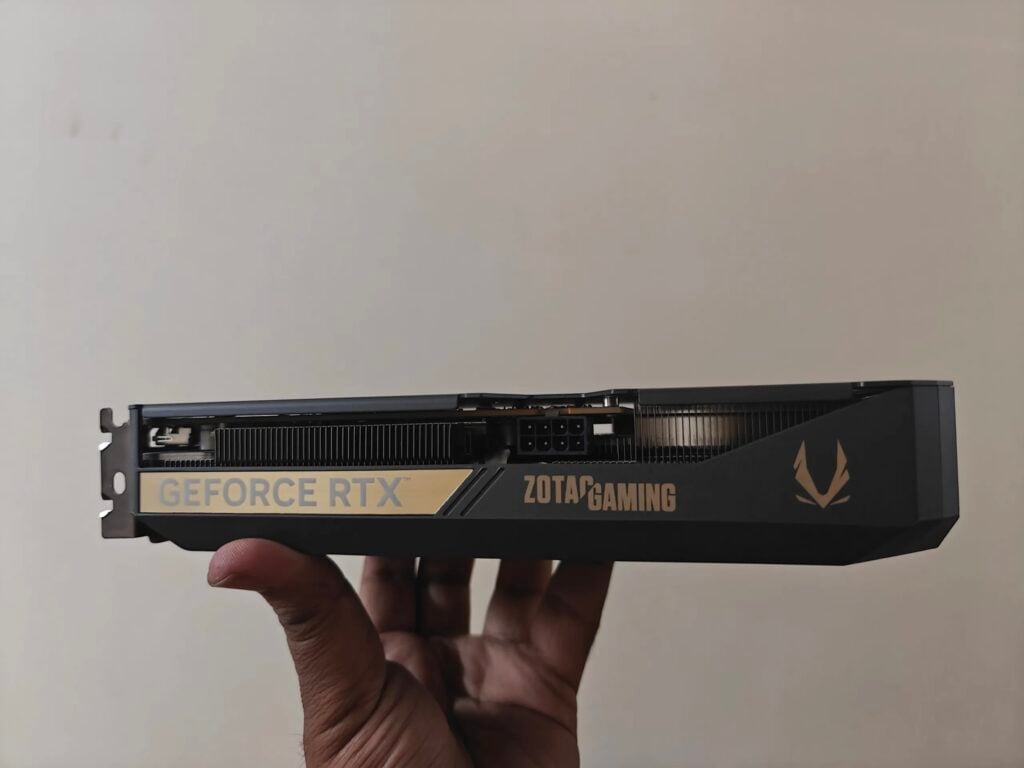
DLSS 4 and AI Features: The Game Changer
The RTX 5060’s biggest strength lies in NVIDIA’s revolutionary DLSS 4 technology. This AI-powered suite includes:
1. DLSS Super Resolution: Upscales lower resolution images to maintain high frame rates while preserving image quality
2. DLSS Ray Reconstruction: Improves ray tracing quality by using AI to reconstruct lighting details
3. Multi Frame Generation (MFG): Exclusive to RTX 50 series, generates up to 3 additional frames for every rendered frame
- 2x mode: Generates 1 additional frame
- 4x mode: Generates 3 additional frames
Using the Balanced preset with DLSS, Cyberpunk 2077 leaps to 164 FPS at 1080p and 137 FPS at 1440p, while Horizon Zero Dawn climbs to 180 FPS and 138 FPS.
Real-World Impact: DLSS 4 effectively doubles or even quadruples frame rates in supported titles, making ray-traced gaming genuinely accessible at 1080p and transforming otherwise marginal 1440p performance into smooth experiences.
Thermal Performance and Acoustics
At a noise normalized 40 dBA, the card was able to achieve a temperature of 62°C at 1,921 RPM. The sound profile itself was smooth and did not suffer audible oscillations.
Temperature Testing
During FurMark’s GPU stress test at 1440p for over 10 minutes, the GPU temperature hovered around 65-66°C with the card running quietly at an average fan speed of about 1,730 RPM, or roughly 48% of its max speed.
Temperature Results:
- Idle: 35-40°C (fans stopped)
- Gaming Load: 62-66°C average
- Stress Test Peak: 68-70°C
- Hotspot: ~75-78°C
The IceStorm 2.0 cooling solution proves more than adequate for the RTX 5060’s 160-180W power draw. The cooling performance scaled well from 30% fan speed at 79°C to 100% fan speed at 53°C, with 75% appearing to be the point of diminishing returns.
Noise Levels
- Idle: 0 dB(A) (fans stopped)
- Gaming: ~32-35 dB(A)
- Stress Test: ~38-40 dB(A)
The Twin Edge maintains impressively quiet operation even under sustained loads. The FREEZE fan stop feature ensures complete silence during desktop tasks, web browsing, and video playback.
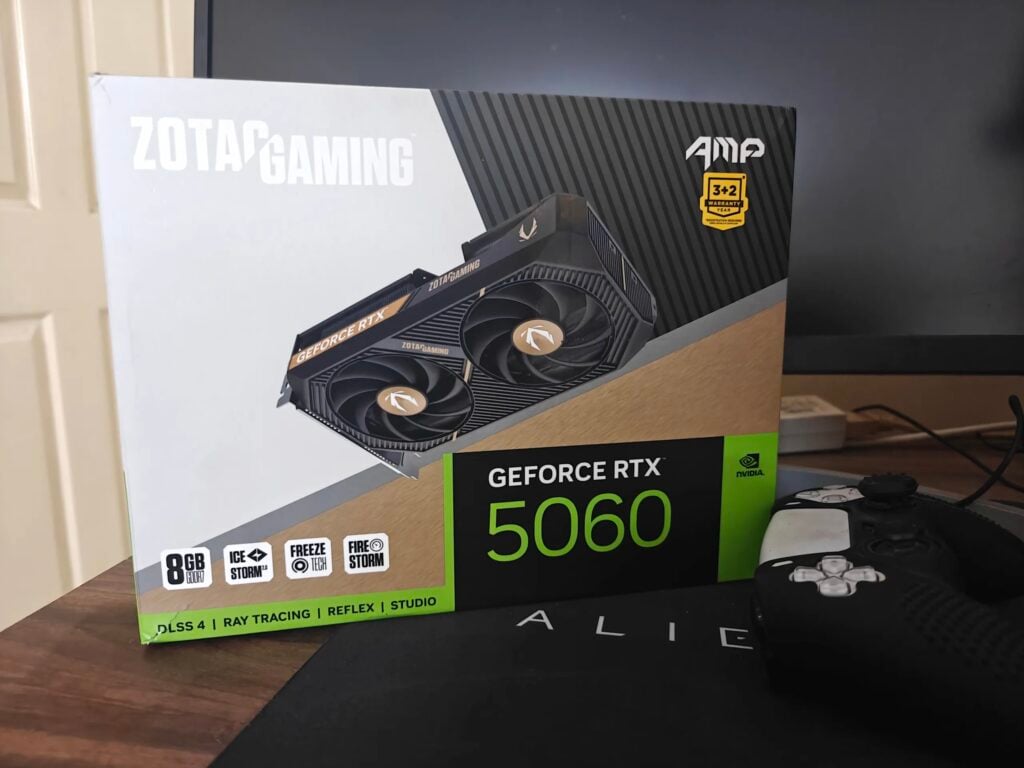
Power Consumption: Efficiency Champion
One area where the RTX 5060 really excels is power draw, with test rigs only drawing a peak of 274W from the mains with the RTX 5060 running at full load.
Power Draw Measurements:
- Idle: 15-20W
- Gaming Average: 140-160W
- Gaming Peak: 170-180W
- Total System Draw: 260-280W
The Blackwell architecture’s efficiency shines through, delivering significantly more performance per watt compared to previous generations. This makes the RTX 5060 ideal for:
- Small form factor builds with limited PSU options
- Systems prioritizing low heat output
- Budget builds where PSU upgrades aren’t feasible
The 8GB VRAM Elephant in the Room
Let’s address the controversy: The RTX 5060 still only has 8GB of VRAM, and that’s proving to be a major restriction on its capabilities. It’s a baffling decision that means the RTX 5060 falls over in some games if you run it above the Medium graphics preset, even at 1,920 x 1,080.
When 8GB Works
✅ 1080p gaming at High/Ultra settings (most titles) ✅ Esports titles at any resolution ✅ Older AAA games (2018-2022) ✅ DLSS-enabled titles at 1080p/1440p ✅ Competitive gaming prioritizing frame rates
When 8GB Struggles
❌ 1440p Ultra textures in modern AAA titles ❌ 4K gaming (completely unsuitable) ❌ Heavy texture mods or HD texture packs ❌ Ray tracing at 1440p+ without DLSS ❌ Future-proofing beyond 2-3 years
The 8GB VRAM buffer limits gameplay at high resolution or ultra-texture settings, resulting in stutter or frame dips in demanding titles.
PCIe 5.0 x8 Interface: Compatibility Concerns
The RTX 5060 uses a PCIe 5.0 x8 interface rather than the traditional x16. While not ideal even for PCIe 5.0-enabled systems, it becomes a major issue for those on older hardware, especially when restricted to PCIe 3.0.
Bandwidth Comparison:
- PCIe 5.0 x8: 64 GB/s (adequate)
- PCIe 4.0 x8: 32 GB/s (minor limitations)
- PCIe 3.0 x8: 16 GB/s (significant bottleneck)
Recommendation: If you’re building on an older PCIe 3.0 platform (pre-2020 systems), be aware that the narrow interface may limit performance in certain scenarios, particularly in VRAM-constrained games.
FireStorm Software: Control and Customization
The all-new FireStorm utility for RTX 50 Series provides comprehensive control over your graphics card:
Features:
- Real-time GPU monitoring (temps, clocks, usage)
- Custom fan curve creation
- Core and memory overclocking
- Power limit adjustment
- RGB control (non-applicable for Twin Edge)
- Performance profiles
There appears to be good potential to overclock the Zotac Gaming RTX 5060 Ti Twin Edge OC. Achieving +100 on the core was as easy as dialing it in, stable for 20 loops of 3DMARK Speedway.
Real-World Use Cases: Who Should Buy This?
✅ Ideal For:
1. 1080p Enthusiasts: If you primarily game at 1920×1080 and want maximum frame rates with High/Ultra settings, this card excels
2. Competitive Gamers: Esports titles like CS2, Valorant, Fortnite, and Apex Legends run at incredibly high frame rates
3. DLSS Believers: Gamers who embrace AI upscaling and frame generation will extract tremendous value
4. SFF Builders: The compact dimensions and single 8-pin power make it perfect for small form factor PC builds
5. Budget Upgraders: Coming from GTX 1060/1070, RTX 2060, or GTX 1660 series? This represents a massive generational leap
6. Power-Conscious Builds: Low power draw makes it suitable for pre-built systems or limited PSU scenarios
❌ Not Recommended For:
1. 1440p Ultra Gamers: The 8GB VRAM will cause headaches in modern demanding titles
2. Future-Proofing Seekers: VRAM limitations suggest a 2-3 year lifespan before struggling with new releases
3. 4K Aspirations: Simply not viable for 4K gaming at any meaningful quality settings
4. Content Creators: 8GB VRAM insufficient for serious video editing, 3D rendering, or AI workloads
5. PCIe 3.0 Platform Users: Consider alternatives if you can’t upgrade to PCIe 4.0/5.0 motherboard
Value Proposition: Price-to-Performance Analysis
At the $299 MSRP, the RTX 5060 Twin Edge occupies an interesting market position:
Competitors to Consider:
- Intel Arc B580 ($249): Better value at 1080p but lacking DLSS
- AMD RX 7600 ($269): Similar rasterization, inferior ray tracing
- RTX 4060 Ti 8GB (Used ~$280): Slightly slower but mature drivers
- RTX 3070 (Used ~$250-300): More VRAM-limited but strong rasterization
For most gamers today, the RTX 5060 strikes a good balance—it’s affordable, power-efficient, and capable of delivering smooth gameplay in the titles people are playing right now.
Street Pricing: Availability at MSRP varies. Some markets see $320-350 pricing due to demand, which diminishes value significantly.
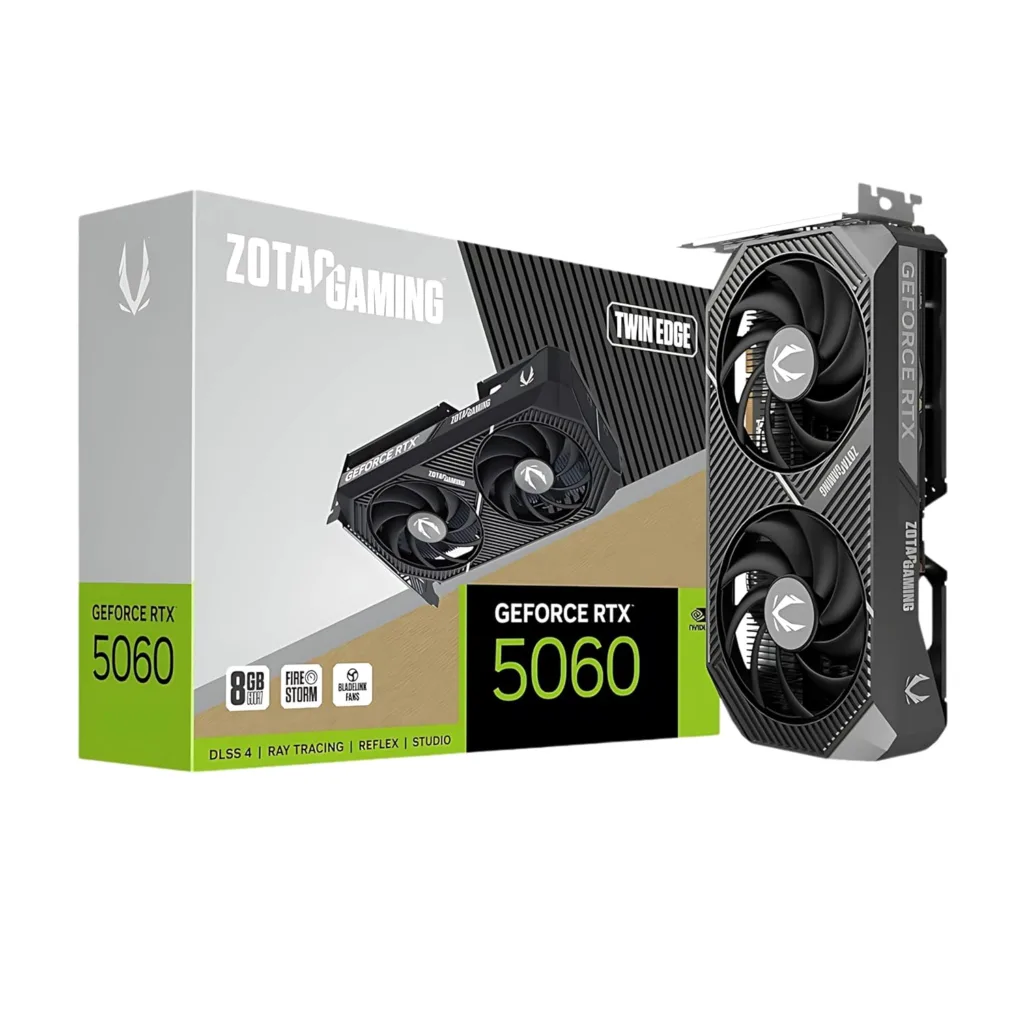
Pros and Cons
Advantages
✅ Excellent 1080p performance across most titles
✅ Compact, SFF-friendly design (220.5mm)
✅ DLSS 4 with Multi Frame Generation
✅ Efficient power consumption (160-180W)
✅ Quiet cooling solution ✅ Single 8-pin power connector
✅ Affordable MSRP ($299)
✅ DisplayPort 2.1b and HDMI 2.1b support
✅ 20-30% faster than RTX 4060
Limitations
❌ Only 8GB VRAM (limiting factor)
❌ Struggles at 1440p Ultra in VRAM-heavy games
❌ PCIe 5.0 x8 interface (older platform concerns)
❌ No RGB lighting (preference-dependent)
❌ Limited future-proofing
❌ Ray tracing requires DLSS for playability
❌ Multi frame generation artifacts in some scenarios
Final Verdict: Conditional Recommendation
The RTX 5060 is a solid continuation of Nvidia’s 60-class legacy, but it’s also a card caught between expectations and compromises. It offers excellent 1080p performance, handles 1440p respectably with the help of DLSS, and benefits from the efficiency of the new Blackwell architecture.
Rating: 7.5/10
The ZOTAC Gaming GeForce RTX 5060 Twin Edge 8GB is a competent 1080p gaming GPU that delivers impressive performance in its intended use case. The Blackwell architecture, DLSS 4, and efficient design make it a compelling option for budget-conscious gamers targeting high-refresh 1080p gaming.
However, the 8GB VRAM limitation casts a shadow over long-term viability. While currently sufficient for 1080p, this constraint will become increasingly problematic as game development continues pushing texture sizes and quality settings.
Our Recommendation:
If you’re a 1080p or an occassional 1440p gamer who embraces DLSS and plans to upgrade within 2-3 years, the RTX 5060 Twin Edge offers excellent value. For those seeking 1440p Ultra gaming or longer-term future-proofing, consider saving for the RTX 5060 Ti 16GB or exploring AMD’s RX 9060 XT when it launches.
If your focus is on 1080p resolution with high-refresh rate or you’re happy to mix in DLSS at 1440p, it makes a lot of sense. But if you’re eyeing more future-proof performance, particularly in ray-traced games or heavy open-world titles, you may find yourself running into the VRAM ceiling sooner than you’d like.
Buy the ZOTAC RTX 5060 Twin Edge on Amazon
For more in-depth graphics card reviews, PC gaming benchmarks, and technology insights, stay connected with TechnoSports.

